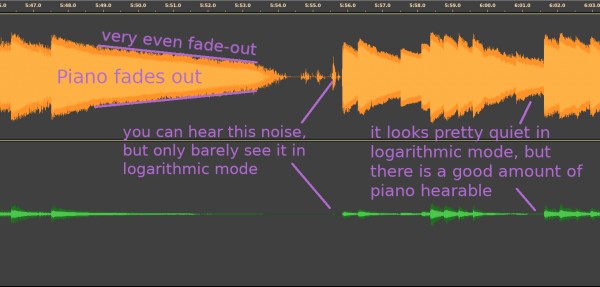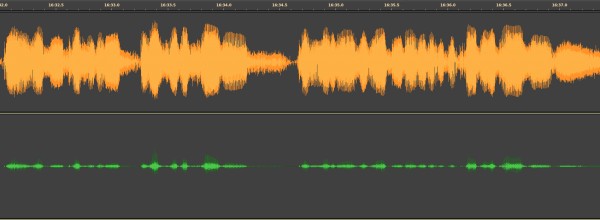Currently, Presonus Studio One can only display waveforms with logarithmic scaling of sample values (dBFS). I can't see any advantage in that and would like to have linear scaling instead.
I wanna give a (rather long) explanation, of why this is. Trust me, this feature will make recording and editing a thousand times easier.
Here are a few example screenshots from Audacity, that allow for comparison of logarithmic and linear scaling mode. The screenshots show two tracks, that contain exactly the same audio file. The upper (yellow-ish) one is scaled liearly, the other (green) one is scaled logarithmically.
Project overview. Notice, how the logarithmically scaled waveform leaves a lot of headroom at some places, where there is actually not much room left (check out the levels on the right of the linear waveform for reference). This can't be solved by zooming, because during the speech part, the waveform already hits the ceiling:

Short section of music. Notice, how easy you can see that the piano actually fades out very evenly, when looking at the linearly scaled wave.:

Closeup look of the speech:

Linearly scaled waveforms are much closer to how humans perceive loudness: The sound pressure level is already the logarithm of some sound pressure value. This is, because loudness is perceived proportionally to some logarithm of the sound pressure. By applying another logarithm (for the logarithmically scaled waveform), we get representations for the audio level that have no connection to perceived loudness anymore. With linear scaling, we would get much better understanding of dynamics in our program, just by seeing the waveform. For example:
- It is much easier to estimate the amount of headroom available (logarithmic movements are more difficult to predict)
- You can develop a very precise sense of how loud different heights in the waveform are
- You can understand dynamics just by looking at them (a linear fall in the waveform will come out as a perfectly even (linear) decrescendo)
A little extra: Paired with an RMS waveform (the brighter areas of the waveforms in the screenshots), you can monitor peaks and approximate loudness live during a recording session. With Audacity, I eventually got to the point, that I didn't have to edit the recording at all before publishing it. It is worth it!